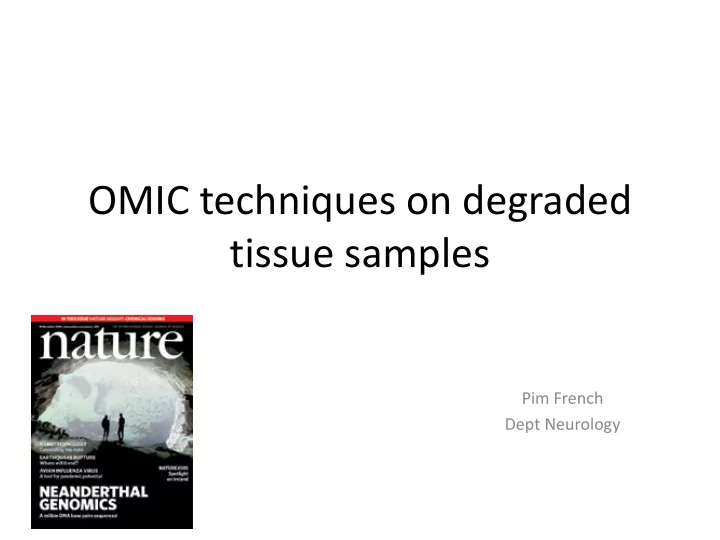

OMIC techniques on degraded tissue samples Pim French Dept Neurology
FFPE • FFPE: formalin fixed, paraffin embedded • The choice of storage for pathology labs – FF tissues: 1000’s – FFPE tissues millions worldwide, ~20 million each year in US – Well characterized samples • Histological • Pathological • Clinical • Clinical trial
Formaldehyde • Formalin=Formaldehyde in solution • Crosslinks primary amino groups through CH 2 linkage
Primary amino group
FFPE and DNA: Protein-DNA and interstrand crosslinks Huang, J Am Chem Soc 1993; Lu, J. Am. Chem. Soc 2010
FFPE fixation comes at a price 1. Degradation: Nicks and Double strand breaks 2. Hydrolysis of N -glycosyl bond 3. Deamination 4. Oxidation 1. 8-hydroxyguanine formation 2. Thymine or cytosine glycol formation 5. Thymine dimers
Storage in FFPE compromizes DNA/RNA quality 1: Degradation • Formalin causes hydrolysis of phosphodiester bonds • Dependent on time in paraffin – (extra variable) – 100 b fragments
Storage in FFPE compromizes DNA/RNA quality 2: Hydrolysis of N -glycosyl bond – Depurination: 10.000/cell/day – Depyrimidination: 500/cell/day
Storage in FFPE compromizes DNA/RNA quality 3: Deamination Rate ~100/cell/day
Storage in FFPE compromizes DNA/RNA quality 4: Oxidation (Glycol formation) • Glycol: two hydroxyl (−OH) groups attached to different carbon atoms. • Thymidine glycol: 100/cell/day Chaw, Biochemistry 1980)
Solving FFPE problem: 1: Adopt method (DNA) • Uracil-DNA glycosylase Do, Oncotarget 2012, Clin Chem 2013
Solving FFPE problem: Repair damage • Mono-methylol group additions (-CH2 OH) can be reversed by heat Arutyunyan, Izvestiya Akademii Nauk SSSR, Seriya Khimicheskiya, 1968. • Enzymatic FFPE restoration – mix of various DNA repair enzymes – cocktail of (proofreading) DNA polymerase, DNA repair enzyme and ligase
Problems working with FFPE tissue samples: RNA • RNA: Most arrays/methods are 3’ based and no longer work
Solving FFPE problem: Adopt method (RNA) • Revert chemical modification • Use random primers for cDNA synthesis • But: – only mRNA has poly A tail – mRNA is only ~2% of all RNA in a cell • Requires rRNA depletion – Ribominus mRNA: proteins (~2%) rRNA: ribosomes (~80%) – Ribo zero tRNA: codons (~15%) • LNA to rRNA specific sequences
Examples of high throughput methods using FFPE tissues • Array based – DNA • Oncoscan DX (Affymetrix) • Methylation arrays (Illumina) – RNA • Exon arrays (Affymetrix) • DASL (Illumina) • Sequencing – DNA – RNA
DNA-arrays: Oncoscan
DNA methylation
DNA methylation on FFPE tissues
Molecular diagnostics on FFPE
Targeted sequencing: PCR • Small PCR amplicons Histology Molecular
Targeted sequencing: Baits Illumina TruSeq, Agilent Sureselect, Roche/Nimblegen etc
Exome sequencing: Mutations Gad Getz, Kristin Ardlie
Exome sequencing: CNV Gad Getz, Kristin Ardlie
RNA expression: Exon array
RNA-Seq
Agilent sureselect
Conclusions • Analysis of FFPE tissues is feasible (RNA/DNA/Methylation) • Be aware of noise in the data
Recommend
More recommend